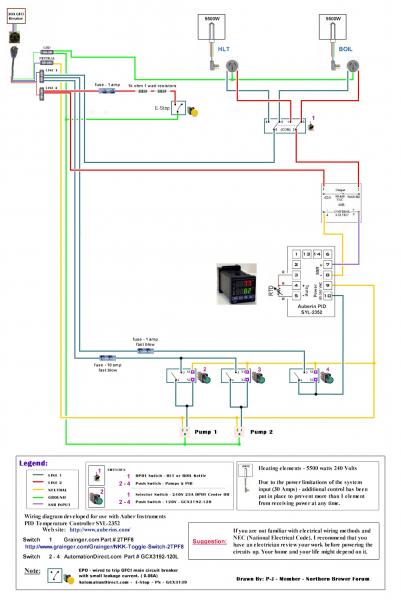O'Haggerty
Well-Known Member
Or anyone who can give a solid answer to the following questions...
This thread was extremely helpful... https://www.homebrewtalk.com/f170/suggestions-controller-249400/index4.html
but the parts list excel file has multiple extra/unneeded options that I'm having trouble sorting through.
For starters,
- My build is for a 220v/30amp/3 wire power source run through a 50A GFCI spa panel into a controller box.
- The brewery electrical requirements consist of:
2x 5500W elements (HLT + BK, only running 1 element at a time)
2x 120v march pumps (running simultaneously at times)
- My controller box consists of:
auber 1/16 din controller project box
auber PID SYL-2352
auber 40A ssr + heatsink
I am building my control box based off this wiring schematic from PJ:

I have ordered the following with no issues:
- PID
- Project box
- 40A ssr + sink
- weldless RTD probe +QD mount
- yellow EPO switch
- 4 120v indicator LEDs (2 red for "element on", 2 blue for "pump on")
Ok finally my issues... the switches. You linked in the above thread that a 3PDT Toggle will be sufficient to switch/power either element plus feed the corresponding indicator light.
1) The specs say 25A@120V... 9A@240V... 9a isnt enough to power the element at 240v... am I just misunderstanding the amperage/leg or what? Can you confirm a link for the switch I need to order to accomplish this?
2) Also... according to the diagram the SSR only intersects one of the 120v legs... so if the PID/SSR is off, isn't the element still getting 120v from the other leg?
3) I want indicator lights for "pump on" for each of the pump toggles... which switch do I need for that action?
4) The connector to the element in the diagram is only 3 prong... wasn't the point to create 4 wire output? (through addition of an equipment ground/GFCI) Or do the elements just not receive a neutral?
I'm obviously no electrical expert but I'm very handy and feel comfortable taking on this project. I'll post any more questions that arise before powering anything up. Thanks for your help!
- Aj
This thread was extremely helpful... https://www.homebrewtalk.com/f170/suggestions-controller-249400/index4.html
but the parts list excel file has multiple extra/unneeded options that I'm having trouble sorting through.
For starters,
- My build is for a 220v/30amp/3 wire power source run through a 50A GFCI spa panel into a controller box.
- The brewery electrical requirements consist of:
2x 5500W elements (HLT + BK, only running 1 element at a time)
2x 120v march pumps (running simultaneously at times)
- My controller box consists of:
auber 1/16 din controller project box
auber PID SYL-2352
auber 40A ssr + heatsink
I am building my control box based off this wiring schematic from PJ:

I have ordered the following with no issues:
- PID
- Project box
- 40A ssr + sink
- weldless RTD probe +QD mount
- yellow EPO switch
- 4 120v indicator LEDs (2 red for "element on", 2 blue for "pump on")
Ok finally my issues... the switches. You linked in the above thread that a 3PDT Toggle will be sufficient to switch/power either element plus feed the corresponding indicator light.
1) The specs say 25A@120V... 9A@240V... 9a isnt enough to power the element at 240v... am I just misunderstanding the amperage/leg or what? Can you confirm a link for the switch I need to order to accomplish this?
2) Also... according to the diagram the SSR only intersects one of the 120v legs... so if the PID/SSR is off, isn't the element still getting 120v from the other leg?
3) I want indicator lights for "pump on" for each of the pump toggles... which switch do I need for that action?
4) The connector to the element in the diagram is only 3 prong... wasn't the point to create 4 wire output? (through addition of an equipment ground/GFCI) Or do the elements just not receive a neutral?
I'm obviously no electrical expert but I'm very handy and feel comfortable taking on this project. I'll post any more questions that arise before powering anything up. Thanks for your help!
- Aj










